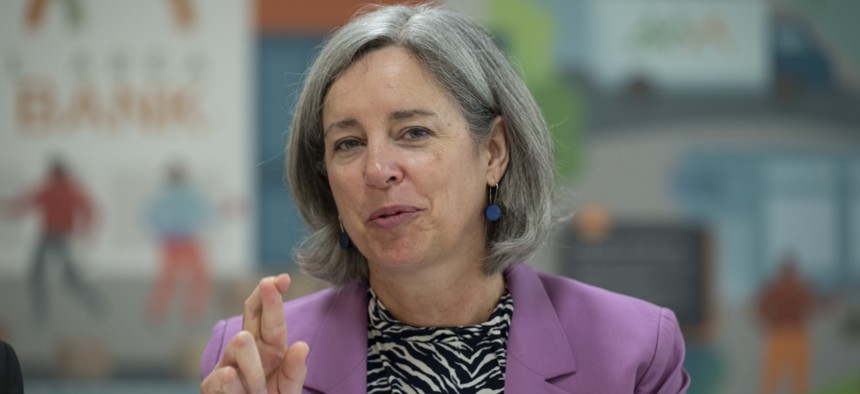USDA hopes more data access will improve states’ SNAP delivery

Stacy Dean, USDA's deputy undersecretary for food, nutrition and consumer services, speaks at a roundtable discussion at the Capital Area Food Bank in Washington, D.C. on October 27, 2023. USDA photo by Tom Witham
The Agriculture Department is also working to help states address card skimming and other persistent problems in the SNAP program.
USDA is expanding the data backbone behind the nation’s largest domestic food benefits program, the Supplemental Nutrition Assistance Program, in a bid to help states verify the income of claimants on the back end of systems more quickly.
A new contract supporting this effort is one of several ongoing modernization pushes at the agency, which also includes proposed quality control rules and at least $15 million in grants.
“We need to be working across the board to make sure that this program, fundamentally, is getting the right benefits to the right folks in a timely manner, with strong customer service,” Stacy Dean, deputy undersecretary for USDA’s Food, Nutrition and Consumer Services told Nextgov/FCW in a recent interview. “We are constantly looking for ways to improve.”
The $198.7 million, five-year contract awarded to Equifax and Experian in September will give states access to payroll databases to verify the income and employment of applicants and SNAP participants.
Dubbed the SNAP Earnings Verification Service, the new, national-level contract covers all states; Washington, D.C.; Guam; and the Virgin Islands at no cost to those users, according to a USDA spokesperson.
Currently, about 36 SNAP agencies have independent Equifax contracts, but many are priced per data match, so many states ration their use, according to the spokesperson. The USDA contract includes unlimited matches for a fixed price, meaning that agencies can use the data as their first way to validate people, the spokesperson said.
The goal is to establish a streamlined process both within SNAP agencies and for recipients of the program, who may not have to provide pay stubs if they can be verified by these datasets, according to the agency.
“The states have really appreciated their relationship with Equifax, but wanted to expand their efforts to use third-party datasets to verify income, and this is our way to supplement and support that,” said Dean.
The idea of using data behind the scenes to support better experiences for those interacting with government services also featured in the Biden administration’s customer experience executive order, which directed USDA to find opportunities to simplify enrollment and recertification for nutrition assistance programs, including through direct certification.
USDA isn’t looking only to the private sector for data — the agency is also cooperating with the Social Security Administration on benefits access. SSA notifies recipients of the Supplemental Security Income program of SNAP benefits and does intake on SNAP applications from certain households.
Apart from the new contract, USDA also recently awarded at least $15 million across four grant programs to 17 state and local agencies for anti-fraud work, adding robotic process automation behind the scenes and remote identity proofing on online accounts, Social Security number validation and more.
Another $3 million in awards across D.C. and Kentucky will establish research databases on SNAP participation over time. USDA is also updating its quality control rule to improve the payment accuracy data it receives from states.
Simultaneously, the agency is also dealing with ongoing problems with card skimming, where bad actors attach devices to ATMs or card swiping machines to copy EBT card information, which they can then use to clone the cards and purchase food with stolen benefits.
Late last year, Congress passed a provision allowing states to replace stolen benefits through the end of September 2024 using federal funds. Across 10 states submitting data to USDA, nearly $6 million in stolen benefits has been replaced so far. In Tennessee alone, there were over 4,000 reports from victims of the fraudsters between July 2022 and November 2023 alone.
USDA is working through questions about what protections it can add to the program in areas like card security, as well as working on a forthcoming regulation on benefits security, Dean said. Five states are piloting contactless payments, and USDA is also providing technical support to states trying out chip-enabled cards, according to the agency.
More broadly, USDA is also trying to help states navigate the end of pandemic-era flexibilities in how they administer SNAP, according to Dean, who said that USDA is “trying to be sensitive for all that [states] have to do and yet still set very clear standards for the service that they have to offer.”
As for the stakes, “SNAP isn’t the goal in and of itself,” she said. “It’s a tool to help us try to, as a nation, ensure that no one in this country goes hungry and that economic insecurity doesn’t equal food insecurity.”






